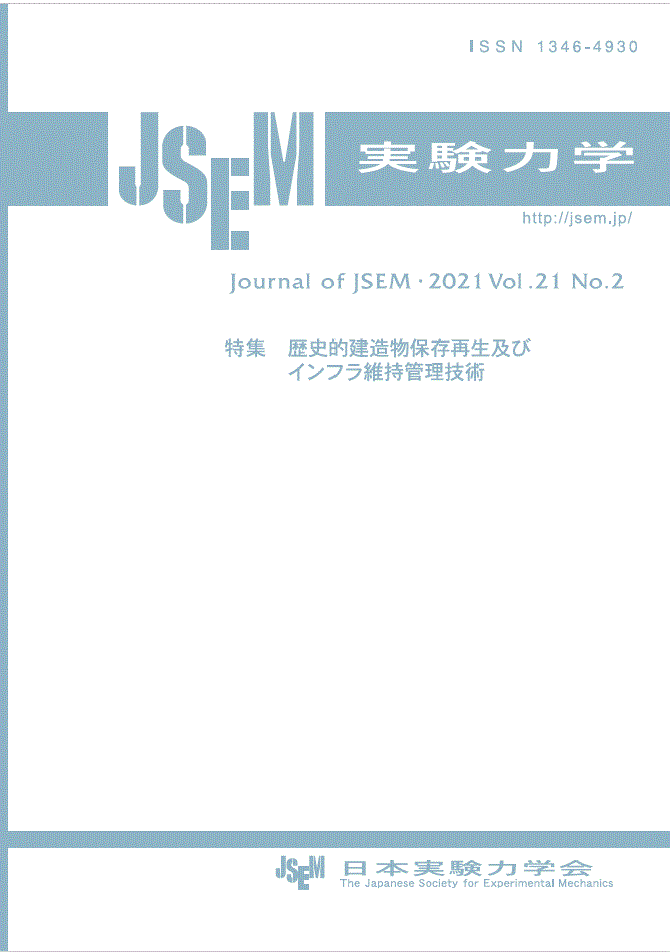Volume 21, Issue 2
Displaying 1-20 of 20 articles from this issue
- |<
- <
- 1
- >
- >|
Foreword
-
Article type: other
2021Volume 21Issue 2 Pages 71
Published: July 03, 2021
Released on J-STAGE: September 09, 2021
Download PDF (1513K)
Special Issue on Preservation/Renovation of Historical Buildings and Maintenance Technology of Infrastructure
-
Article type: other
2021Volume 21Issue 2 Pages 72
Published: July 03, 2021
Released on J-STAGE: September 09, 2021
Download PDF (1430K)
Review
-
Article type: review-article
2021Volume 21Issue 2 Pages 73-76
Published: July 03, 2021
Released on J-STAGE: September 09, 2021
Download PDF (3807K) -
Article type: review-article
2021Volume 21Issue 2 Pages 77-83
Published: July 03, 2021
Released on J-STAGE: September 09, 2021
Download PDF (6259K)
Original Papers
-
Article type: research-article
2021Volume 21Issue 2 Pages 84-90
Published: July 03, 2021
Released on J-STAGE: September 09, 2021
Download PDF (13954K) -
Article type: research-article
2021Volume 21Issue 2 Pages 91-96
Published: July 03, 2021
Released on J-STAGE: September 09, 2021
Download PDF (5311K) -
Article type: research-article
2021Volume 21Issue 2 Pages 97-103
Published: July 03, 2021
Released on J-STAGE: September 09, 2021
Download PDF (11097K) -
Article type: research-article
2021Volume 21Issue 2 Pages 104-109
Published: July 03, 2021
Released on J-STAGE: September 09, 2021
Download PDF (2398K) -
Article type: research-article
2021Volume 21Issue 2 Pages 110-118
Published: July 03, 2021
Released on J-STAGE: September 09, 2021
Download PDF (17467K) -
Article type: research-article
2021Volume 21Issue 2 Pages 119-126
Published: July 03, 2021
Released on J-STAGE: September 09, 2021
Download PDF (7927K)
Original Papers
-
Article type: research-article
2021Volume 21Issue 2 Pages 127-133
Published: July 03, 2021
Released on J-STAGE: September 09, 2021
Download PDF (3021K) -
Article type: research-article
2021Volume 21Issue 2 Pages 134-138
Published: July 03, 2021
Released on J-STAGE: September 09, 2021
Download PDF (1490K) -
Article type: research-article
2021Volume 21Issue 2 Pages 139-149
Published: July 03, 2021
Released on J-STAGE: September 09, 2021
Download PDF (16402K) -
Article type: research-article
2021Volume 21Issue 2 Pages 150-155
Published: July 03, 2021
Released on J-STAGE: September 09, 2021
Download PDF (4140K) -
Article type: research-article
2021Volume 21Issue 2 Pages 156-161
Published: July 03, 2021
Released on J-STAGE: September 09, 2021
Download PDF (1531K)
Technology Award Winners
-
Article type: other
2021Volume 21Issue 2 Pages 162-163
Published: July 03, 2021
Released on J-STAGE: September 09, 2021
Download PDF (5928K) -
Article type: other
2021Volume 21Issue 2 Pages 164-165
Published: July 03, 2021
Released on J-STAGE: September 09, 2021
Download PDF (1378K)
Academic Encouragement Award Winners
-
Article type: other
2021Volume 21Issue 2 Pages 166-167
Published: July 03, 2021
Released on J-STAGE: September 09, 2021
Download PDF (7964K) -
Article type: other
2021Volume 21Issue 2 Pages 168
Published: July 03, 2021
Released on J-STAGE: September 09, 2021
Download PDF (772K)
Tutorials
-
Article type: other
2021Volume 21Issue 2 Pages 169-172
Published: July 03, 2021
Released on J-STAGE: September 09, 2021
Download PDF (12162K)
- |<
- <
- 1
- >
- >|
